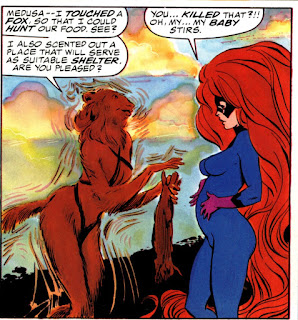The Inhumans
Marvel Graphic Novel, 1988
'The Inhumans' is Marvel graphic novel No. 39, and was published in 1988. The story is by Anne Nocenti, with art by Bret Blevins, inks by Al Williamson, letters by Novak and Saladino, and colors by Michael Higgins.
'The Inhumans' opens with a tragedy taking place in the Inhuman's city of Attilan, on Earth's Moon. The reader learns that the judges of the Genetic Council have implemented a eugenics policy that dictates which members of the race can marry, and reproduce, with others. The justification for this policy is to avoid birthing individuals whose traits may - inadvertently or deliberately - lead to the death and destruction of the Inhumans. Needless to say, this draconian policy is the cause of much tension in Inhuman society.
We learn that Medusa, wife of Inhumans leader Black Bolt, is herself pregnant........and must present herself to the Council and accept their judgment as to whether she will be allowed to bear the child.
Aware that Black Bolt is capable of destroying Attilan simply by speaking, the Elders decide that it is too risky to permit Medusa to give birth to the progeny of such a powerful being. This stance, of course, causes consternation among the Inhumans.
Determined to have the baby, Medusa uses Lockjaw to teleport herself to a wasteland in the Midwest, where she sets up in an abandoned house. The other Inhumans join her and agree to defend her from any who would try to enforce the Council's diktat.
However, Maximus, Black Bolt's psychopathic brother, has escaped his prison in Attilan and travels to Earth with unsavory designs on Medusa........and the terrain around her hideout has begun to display a disquieting tendency to act as if it is somehow sentient......and dangerous. Events soon are moving towards a crisis, one that jeopardizes not only the Inhumans, but perhaps their entire race as well...............
Marvel produced some pretty awful comics during the 1980s, but this is one of the worst. It's really, really bad.
Sometimes superior art can salvage a bad story, but Bret Blevins's art has a hasty, half-finished quality, as shown in this panel where little effort was made to render recognizable human figures:
Nocenti's writing relies on a steady stream of melodramatic confrontations between the various Inhumans:
These are so pervasive that at some point Nocenti must have realized that any Fanboys who ventured to read 'The Inhumans' were going to be turned off, so she arranged for some cheesecake to hold their attention.
Thus we have a shape-shifting girl, named Minxi, who wears the barest strips of black fabric; and some panels of Crystal, taking a bath:
The plot gets increasingly difficult to follow. Story beats are tossed in haphazardly, with little effort at coherence (for example, Triton periodically shows up in a parallel plot thread, says something angst-y, and then vanishes) and the corny, cliche-riddled dialogue fails to improve.
I won't divulge any spoilers, but I found the denouement to be underwhelming, so much so that it renders all of the Sturm und Drang in the preceding pages moot.
Summing up, 'The Inhumans' is an exemplar of what can go wrong when comics writers are given leeway to craft a narrative that serves as a conduit for their aspirations of being a Meaningful Writer. They may have intended to use the medium to say something Profound about society, kinship, responsibility, motherhood, etc., etc., but instead present a stream of theatrical posturings. Stay away from this one !












































































